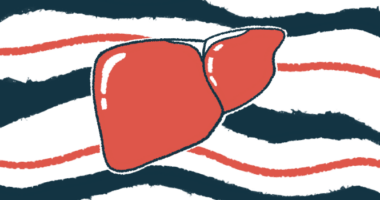Lanifibranor may be reason for liver gains seen in Phase 3 MASH trial
Interim pooled analysis finds benefits compare well with Phase 2 study results

Signs of improved liver health are evident in biomarker and liver scarring assessments of people with metabolic-associated steatohepatitis or MASH — a severe form of fatty liver disease — enrolled in a placebo-controlled Phase 3 clinical trial of lanifibranor, a potential oral MASH treatment.
These pooled results cover both treatment and placebo groups in the global NATIV3 study (NCT04849728) at an interim and blinded analysis of 664 people after up to 72 weeks (nearly 1.5 years). It’s currently unknown if the observed benefits come from treated patients or those on a placebo.
But these early findings are generally comparable to final data from a previous six-month study of lanifibranor in MASH patients, the Phase 2b NATIVE trial (NCT03008070), and they suggest “that lanifibranor is having the expected benefits,” the therapy’s developer, Inventiva, announced in a company press release.
The Phase 3 trial to date has enrolled 837 patients, 85% of its target enrollment, with screening underway at nearly 360 sites across 24 countries. Top-line study results expected by late 2026.
Phase 2b trial found daily lanifibranor eased highly active MASH in adults
“We remain confident in the ongoing progress of our Phase 3 NATiV3 clinical trial,” said Frédéric Cren, chairman, CEO, and co-founder of Inventiva. “We would like to thank our key partners and the clinical trial sites on the Phase [3] clinical trial for their continued efforts and engagement in our study which is reflected in the progress in the recruitment for NATiV3.”
Formerly known as nonalcoholic steatohepatitis (NASH), MASH is characterized by the buildup of fatty deposits in the liver (steatosis) that lead to inflammation and scarring, or fibrosis.
The disease is associated with risk factors for metabolic syndrome, including obesity, high blood pressure, high blood levels of fatty molecules, and the elevated blood sugar (glucose) levels that mark type 2 diabetes.
Lanifibranor is an orally available small molecule with antifibrotic, anti-inflammatory, and beneficial metabolic properties. It activates three forms of PPAR (PPAR-alpha, PPAR-delta, and PPAR-gamma), a protein group that regulates the activity of genes involved in MASH-related processes.
In the Phase 2b NATIVE study, which enrolled 247 adults with highly active MASH and type 2 diabetes or moderate to advanced liver fibrosis, 1,200 mg of lanifibranor taken once daily significantly reduced disease activity without worsening fibrosis after 24 weeks (about six months).
Another Phase 2 trial, called LEGEND (NCT05232071), tested lanifibranor — taken with or without Boehringer Ingelheim’s diabetes medication Jardiance (empagliflozin) — against a placebo in 42 MASH patients with poorly controlled type 2 diabetes. Interim data showed lanifibranor safely reduced blood sugar levels and eased signs of liver disease.
Patients in NATiV3 study given lanifibranor at one of two doses, or a placebo
NATiV3 is designed to test lanifibranor in adults with MASH and moderate to advanced liver fibrosis. Eligible patients include those with MASH on liver biopsy, type 2 diabetes with a high waist circumference or obesity, or liver steatosis on ultrasound.
It consists of two sequential parts: an initial placebo-controlled phase followed by an active treatment extension phase, in which all participants receive the therapy for a longer period.
The 837 enrolled patients have been randomly assigned to one of two lanifibranor doses (800 mg and 1,200 mg) or to a placebo, taken once daily for 72 weeks.
A recent analysis demonstrated that the study’s statistical powering was expected to exceed 95% for both doses evaluated, meaning differences between lanifibranor and the placebo should be detectable.
Clinical characteristics of NATiV3 participants at the study’s start aligned with those in the NATIVE trial, and 13% of enrolled patients were on a stable dose of GLP-1 receptor agonists, a class of medications used to treat type 2 diabetes and obesity. Including these patients “should provide valuable insights into the potential benefits of a combination of this class of products with lanifibranor,” the company noted in the release.
NATiV3’s primary goal is to assess the proportion of patients showing MASH resolution and reduced fibrosis at week 72, as assessed by MASH Clinical Research Network (MASH CRN) scores.
The blinded analysis of NATiV3’s pooled treatment and placebo group data involved 545 patients at week 24 (nearly six months) and 119 patients at week 72. Results showed improved liver function, reduced fibrosis (also assessed with transient elastography or Fibroscan), and lower blood fat and glucose levels.
Weight gain, observed after six months in the NATIVE trial, appeared to plateau and stabilize in NATiV3 after 24 to 36 weeks. If these findings are confirmed, it would highlight lanifibranor’s profile compared with the diabetes medication pioglitazone (sold under the brand name Actos, among others), which activates PPAR-gamma alone and has shown no such plateau effect, Inventiva noted.
NATiV3 also includes an exploratory group of MASH patients whose liver biopsy failed to support fibrosis. Inventiva believes findings in this group may allow for additional data, collected through noninvasive tests, to support a future regulatory submission for the therapy’s approval.








